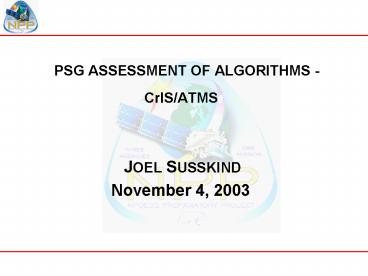PSG ASSESSMENT OF ALGORITHMS CrISATMS - PowerPoint PPT Presentation
1 / 13
Title:
PSG ASSESSMENT OF ALGORITHMS CrISATMS
Description:
CrIMMS EDR algorithm has been developed and tested with simulation data. NOAA 88 radiosonde data set (no cloud data) ... The same 'truth' data sets were used by ... – PowerPoint PPT presentation
Number of Views:35
Avg rating:3.0/5.0
Title: PSG ASSESSMENT OF ALGORITHMS CrISATMS
1
PSG ASSESSMENT OF ALGORITHMS - CrIS/ATMS
- JOEL SUSSKIND
- November 4, 2003
2
CrIMMS EDR ALGORITHM
- CrIMMS EDR algorithm has been developed and
tested with simulation data - NOAA 88 radiosonde data set (no cloud data)
- AIRS December 15, 2001 data set - GCM derived
fields including clouds - The same truth data sets were used by the AIRS
Science Team to generate - AIRS pre-launch retrieval algorithm
- In simulation AER CrIMMS retrieval algorithm
performs comparably to AIRS team algorithm
modified to handle CrIMMS data - Real data contains complications not found in
simulation - Further modifications to AER algorithm will be
needed to handle real data
3
LIMITATIONS OF SIMULATION EXPERIMENTS AS PERFORMED
- Physics
- Perfect knowledge of physics was assumed
- Non-local thermodynamic equilibrium (non-LTE)
was ignored - Knowledge of instrument SRFS was assumed to be
perfect - Scenes
- Cloud and surface parameters were model
generated - There was no sub-pixel variability in the scenes
- clouds, surface parameters, etc.
- Variability of upper tropospheric water vapor
and trace gases was - unrealistic
4
EXPERIENCE OF AIRS SCIENCE TEAM WITH OBSERVED
AIRS DATA
- Differences exist between observed AIRS radiances
and those computed from truth - Larger differences exist for AMSU A brightness
temperature - antenna pattern uncertainty - Bias correction (tuning) needed for observed
minus computed brightness temperature - Residual tuning error must be included in
channel noise covariance matrix - More channels affected by non-LTE than previously
assumed - Cloud clearing is working well for the most part
but - some homogeneous low stratus clouds at night are
undetected - weak cirrus cloud emissivity signal is found in
some clear column radiances - Surface emissivity variability over land is
causing some problems - Rejection tests and thresholds needed to be
modified - Eighteen months after launch, AIRS products are
approaching required - accuracy
- More research is still needed
5
PREDICTION OF OBSERVED CrIS FROM OBSERVED AIRS
- are determined
from extensive simulation using AIRS - retrieved
parameters as truth scenes - Method tested successfully by predicting AIRS
from AIRS - Two whole days of CrIS data have been predicted -
Sept. 6, 2002 and Jan. 25, 2003 - Observed AMSU data is appended
- Because observed AIRS data is used, most
limitations of simulation are accounted for - Degui Gu at NGST is studying this data set
- His recommendations for needed EDR algorithm
work are analogous to AIRS experience
6
ADDITIONAL EDRs THAT CrIS COULD PRODUCE
- A number of additional EDRs are being derived
from AIRS - CrIS is capable of giving the same products
- Cloud top height and fractional cloud cover
- Useful in its own right for climate studies
- Used by Bob Atlas in data assimilation
experiments - Computed OLR
- Helps explain variability of OLR in terms of
component parts - Total O3, O3 profile
- Needed to supplement OMPS at night, polar
winter - Should use 9.6 mm band - not in current
algorithm - Trace gas (CO2, CH4) profiles and possibly
total CO2 burden
7
CrIS SDR ALGORITHM
- SDR algorithm is very complex and needs review by
science team - Particular concern exist with regard to
- Adjusting SDRs in different detector positions
to SDRs with a common ILS - What is the nature of the error (noise)
introduced by this - procedure?
- To what extent does cloud obscuration affect
ILS and effective SDR noise - CrIS data predicted from AIRS observations does
not address these factors
8
- BACK UP CHARTS
9
AIRS CHANNEL NOISE REDUCTION
- There are many more AIRS channel
than independent pieces of information
- Use of the whole spectrum predicts more
accurately than it can be measured - METHOD
- Simulate noisy and noise free AIRS radiances
- Find regression relationship
-
- A is block diagonal - LW, MW, SW
- Use as truth retrieved state (all parameters
including clouds, trace gases, - surface emissivity ..) for all accepted
retrievals for - September 6, 2002 and January 25, 2003
- Generate coefficients on 140,000 cases - test on
280,000 cases - Transformed channel noise covariance matrix
- where is diagonal
with original noise contains off
diagonal matrix elements
10
(No Transcript)
11
(No Transcript)
12
(No Transcript)
13
(No Transcript)































